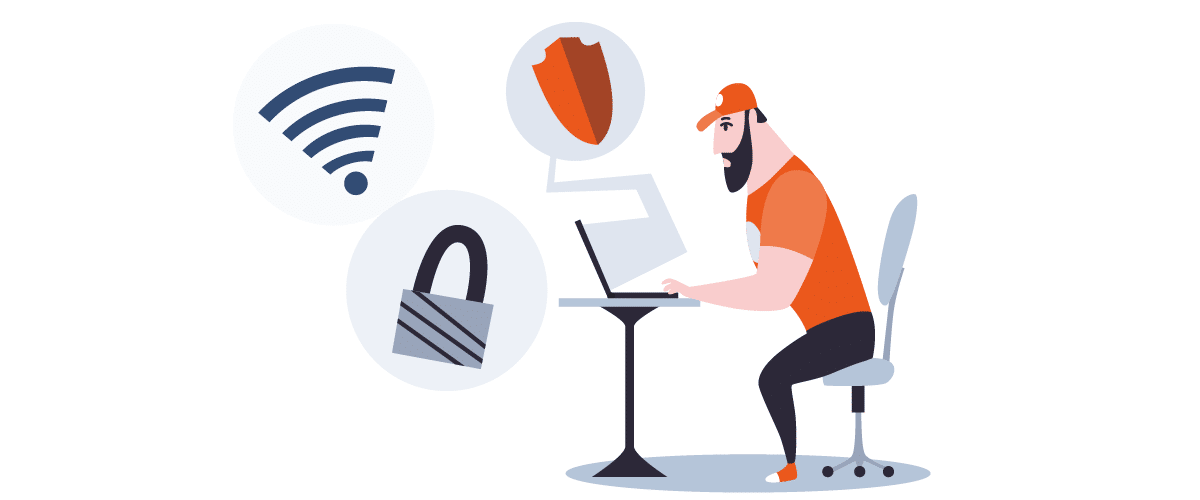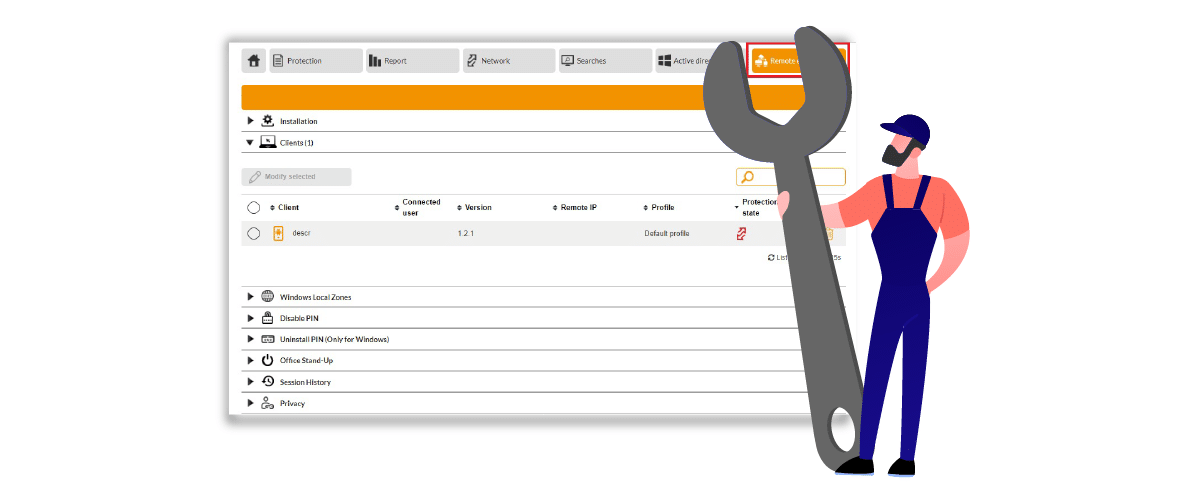
Wifi attacks
Wireless technology offers a variety of benefits to businesses, schools, and organizations. The risks, however, are many. Specifically, this type of connection represents an easier target for hackers, whose wifi attacks can have disruptive effects on the day-to-day operations of the organizations involved. In this post, we will explain the attack methods used on wireless networks and see how FlashStart protects against wifi attacks.
1. Wireless migration
In order to transmit information, the wireless network does not use cables of any kind but, rather, electromagnetic waves which carry the message from the sender to the receiver. Instead of cables, wave transmission uses antennas, which immediately offers an advantage: wireless networks are able to reach a wider area than wired networks and are more flexible in that devices do not need to be connected via cable to an internet modem.
This aspect also makes them less expensive: they run on less hardware and allow many more devices to connect to the same network at the same time, allowing for greater accessibility.
For these reasons, wireless networks have spread rapidly and, increasingly, they are the choice and even influence the choice of users. In fact, it so happens that, needing to work remotely or attend a meeting online, we choose a venue by first checking to see if it offers a free internet connection. Moreover, we now take it for granted that the service is available in places such as hotels, tourist attractions, shopping malls, and on some means of transportation.
1.1 The risks of wireless networks
However, given all of the advantages, why bother with a wireless connection? In addition to the disadvantages related to the speed of the network – in fact, wireless networks are typically less efficient than those derived from the same modems but via a wired connection – there are two major, interrelated problems: security and interference.
If a wireless network is not properly installed or consistently maintained, the security risks are many. In fact, these networks require only the installation of a wireless adapter and, thus, without physical devices in the way, are more easily attacked by hackers who can break in by exploiting vulnerabilities that are also dictated by lack of updates related to security and by ease of access to the network.
In addition, these networks are very susceptible to interference. We are referring to environmental interference – dust, fog, walls, other radio signals – which, in turn, makes it slower to connect and easier for a hacker to attack.
>> FlashStart protects you from a wide array of threats and blocks access to malicious sites ? Request a quotation or try it now

2. The most common types of wifi attacks
Many wifi attacks target wireless networks that have low security controls and are, therefore, easy to attack. For some hackers, these networks represent only an opportunistic access point: once inside, say, a hotel network, hackers lie in wait until a user with a relevant profile connects to this network. In this way, they can download malware onto his or her device and, perhaps, gain access to a large company’s network. The damage in terms of data stolen and ransom demanded – in this case we are talking about ransomware – can be extensive.
A 2016 survey of 31 million wifi hotspots found that more than one in four (28 percent) posed a risk to transmitted data because they were not protected by any kind of encryption or password. Therefore, attention to the security of the network to which one connects must always have top priority.
Besides the more opportunistic attacks described above, there are various types of deliberate wifi attacks that occur when a user connects to a wireless network.
2.1 Page duplication and “Evil Twins” attacks
In these attacks, hackers duplicate the actual wifi network access page, for example, of the aforementioned hotel, very realistically imitating the official page to the point that sometimes they even use the same username and password as the network in question, a similar or otherwise highly intuitive network name, and, why not?, a stronger and more stable internet signal.
It is an “Evil Twin,” created in the image of the official page to induce customers to log onto that network and browse from there Once inside, customers do not notice the difference because their browsing is still guaranteed. Hackers, however, are lurking: they control and monitor the users’ every move until someone enters sensitive data, such as email, – usable for phishing attacks – personal data of various kinds, and, why not?, financial data, such as credit card codes.
2.2 Interception and “sniffing” attacks
“Sniffing” – from the English “sniff,” to smell, to whiff – refers to the activity of intercepting data on the network using software called a sniffer. The sniffer itself is not illegal: these are tools that are used to analyze network traffic and detect anomalies. However, just by their operation, sniffers record anything they encounter on their path, including username and password details.
If used by the wrong, skillful hands, these tools can turn into real weapons, at the disposal of hackers to steal data, monitor user activity, and collect information as long as the user does not also reveal the username and password of, for example, his or her home banking.
>> FlashStart is the DNS filter for wifi attacks, malware, and undesirable contents ? Request a quotation or try it now
2.3 Wifi attacks: an example
In 2014, Israeli cybersecurity researcher Amihai Neiderman launched a wifi attack against Tel Aviv’s public wireless network, just to prove that he could do it. As a Vice article reported, Neiderman scans wifi networks as a hobby to see if they are secure.
And that is how he hacked his city’s network: on his way home from work one evening, he noticed the “FREE_TLV” network, the free municipal wireless network. Through various searches, he was able to trace the network’s provider. With a little research, in just three evenings, he found a vulnerability and built a model of the wifi attack, then notified the provider and worked hand-in-hand with him to fix the problem.

3. Wifi attacks: how to prevent them
However, hackers are not always as gracious as in the case of Amihai Neiderman, and wifi attacks can result in serious losses of information and data for users who are often unaware of the risks they run by connecting to wifi networks. Below are some actions needed to ensure the security of wireless networks.
>> Are your wifi networks unsafe? FlashStart protects your network against wifi attacks, safeguarding all the information that passes through it ? Request a quotation or try it now
3.1 Constant updates and maintenance
All software and applications require updates, and similarly, the routers and hardware needed to create and connect wireless networks is constantly evolving. New versions usually correct security problems highlighted with old ones, so it is important to always download system updates and check if there are new versions of the products we use and how they differ from the current ones.
3.2 Traffic encryption
Wireless networks have specific characteristics, so it is appropriate to use security protocols designed for them. In particular, if the router we have is outdated, it may not support the WPA2 and WPA3 protocols – WiFi Protected Access 2 and 3-which are the most cutting-edge standards among encrypted security protocols for protecting Internet traffic on wireless networks.
>> With FlashStart you can block TikTok for all or just some, for always or just in precise moments: Request a quotation or try it now
3.3 Restriction of wifi access
We would all like to have a powerful and sound network, but this means that our network’s signal will also be audible from outside of our property, headquarters, or building and will, therefore, provide an entry point for outsiders. Therefore, it is important to restrict access to the network and make sure that wifi is only available during business or open hours in order to decrease the risk of a wifi attack.
3.4 Using the FlashStart DNS web filter
FlashStart’s DNS web filter is the ideal solution to protect your wireless network from wifi attacks. The filter works as a checkpoint for all incoming and outgoing traffic, which verifies the IP address that the user wants to reach, through a series of blacklists grouped in the FlashStart cloud, and decides, based on the outcome of the verification, whether or not to allow the transfer to the site.
FlashStart constantly protects your wireless network and all devices wherever they are, from the time it is installed:
» at the router level, ensuring the protection of all devices that connect to the network created by that router;
» at the individual device level, through the ClientShield application, which provides security for devices wherever they connect.
Moreover, FlashStart security relies on a global Anycast network. In an Anycast network, the same IP address corresponds to multiple hosts, so the network sends the user’s request to a single address, and, based on the state of the network, it chooses to which server it will forward the request. This all happens in a fraction of a second, ensuring very low latency in response and an average uptime of 99.62%, according to dnsperf.com, ranking it among the five fastest in the world.
>> FlashStart quickly and consistently protects more than 25 million users against cyber risks ? Request a quotation or try it now
You can activate the FlashStart® Cloud protection on any sort of Router and Firewall to secure desktop and mobile devices and IoT devices on local networks.







